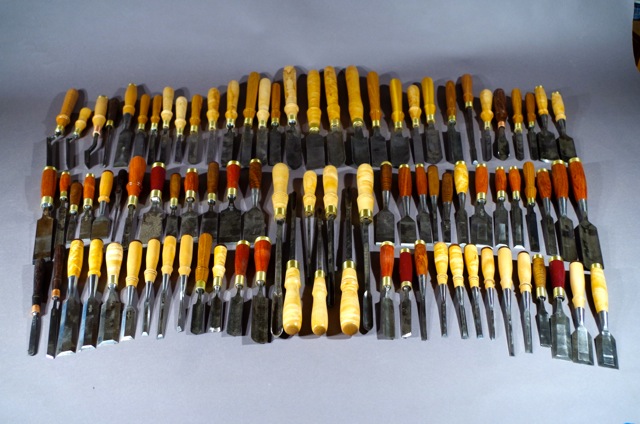
Tom McFadden
F U R N I T U R E
P.O. Box 162 - Philo, CA 95466 - (707) 895-3606
www.mcfaddenfurniture.com - tamcfad@icloud.com
90 Chisels With New Handles

The Chisel Project
I got my Oliver 20-B, a pattern maker’s lathe, midway through the year 2000. Shortly after setting it up I began to look for additional turning chisels and bought some that I found on eBay; 40 chisels for $75.00. The seller said that they had belonged to a man who was a turner on a sailing ship. The chisels look quite old. Many of the handles were obviously made by the man who used them. Some handles are split, they all show wear, and the blades on some of them are ground almost to nothing. There are five two inch roughing gouges, and others came in triple or quadruple numbers too. I wondered why so many of one thing, and quickly realized that with four or five on hand one does not have to stop work and sharpen things very often. I also soon realized that these old tools hold an edge so well that they do not have to be sharpened often. These chisels were made by companies that no longer exist or by companies that metastasized into something not even imagined by their founders. TH Witherby, Buck Brothers, James Swan, W Butcher, T Shaw, Moulson Brothers and others were the makers of these tools, some of them starting business in the 1800’s. The steel in them is fine steel. These tools were made by artisans and they were made to be used by artisans. This steel takes and holds an edge better than anything else, anything new that is, that I have found. I began to wonder if I could find more of these fine old tools, and I did find more. I looked at auctions on eBay, stopped at garage sales, poked through antique stores and wandered flea markets. I don’t mind steel that has discolored over time, but I have avoided steel that is pitted by rust. Many chisels came to me with broken handles, loose handles, or no handles and I decided to make handles for them, hence what I call “The Chisel Project.” I have learned a bit about these things in my years as a studio furniture maker, and I know what kind of handle I want on a chisel: The handle should fit the user’s hand; it should be large enough to get a hold on and the shape should facilitate holding it. The projected use of the chisel determines both what species of wood it is made from and what protection for the handle is built in. The projected use also determines the shape of the handle. I tend to make handles that are a bit larger and a bit more robust than the original one was. To read about chisels for bench work, click here: To read about making chisel handles, click here: